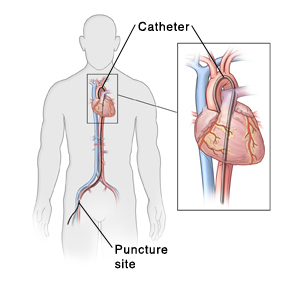Bleeding or Hematoma After Cardiac Catheterization
You recently had cardiac catheterization. A catheter was put into your body through a puncture of an artery in your groin or arm. You now have bleeding from this site. When bleeding occurs, it may drip or spurt from the site. Or it may collect in a lump (hematoma) under the skin. This often requires urgent evaluation in an emergency room. First put direct pressure on the site and call 911 or have someone take you to the emergency room. In the emergency room, more pressure will be put on the site to stop bleeding. You may be sent home if the bleeding can be controlled and you are feeling well enough. To prevent repeat bleeding, take some precautions at home. If the bleeding starts again, follow the advice below.

Home care
For the next 48 hours:
-
Don't do any strenuous activity.
-
Don't climb any stairs if possible
-
Don't lift anything greater than 5 pounds.
-
If the puncture site is in your arm or wrist, don't lie on that arm.
-
If your puncture site is in the groin, don't strain at bowel movements.
-
Don't scrub the site when bathing. It's fine to get it wet after your healthcare provider says it's OK, but don't scrub it or massage it. Don't take a tub bath for 3 days after the procedure.
-
Don't drive for the next 48 hours
If bleeding happens again, call 911. Take the following steps to stop the bleeding until help arrives:
-
Lie on your back.
-
Place a clean cloth or gauze pad over the puncture site. Then hold firm pressure right on the site. Or have someone else apply firm pressure using the gauze pad or washcloth.
-
Keep your arm straight and raised above the level of your heart if the site is in your arm or wrist. If the site is in your groin, have someone else hold pressure on the site.
-
Don't press too hard! If you press too hard, your leg and foot (or arm and hand) will not get blood flow and the skin under your toenails or fingernails may turn white. The skin should look pink, like the toenails on your other foot. When you (or someone) presses on the toenail it will turn white, but when you stop pressing on the nail it will turn pink again. This is called "capillary refill." If there is someone with you, they can check it.
-
If your toes, foot, or leg start feeling numb, tingly, or cold, ease up on the pressure, you are probably pressing too hard.
-
As soon as emergency care arrives, they will take over your care.
Follow-up care
Follow up with your healthcare provider, or as advised. Ask your healthcare provider for a contact number to call.
Call 911
Call 911 if any of these occur:
-
Chest pain or pressure
-
Any bleeding from the site
-
Feeling weak or faint
-
Trouble breathing
-
Lump (hematoma) is quickly getting larger
-
Coolness, numbness, tingling, or skin color changes in the leg or arm with the puncture site
When to seek medical advice
Call your healthcare provider right away if any of these occur:
-
Increased pain, redness, swelling, or drainage from the puncture site
-
Nausea or vomiting
-
Fever of 100.4°F (38°C) or higher, or as directed by your provider
Online Medical Reviewer:
Stacey Wojcik MBA BSN RN
Online Medical Reviewer:
Steven Kang MD
Date Last Reviewed:
1/1/2022
© 2000-2024 The StayWell Company, LLC. All rights reserved. This information is not intended as a substitute for professional medical care. Always follow your healthcare professional's instructions.